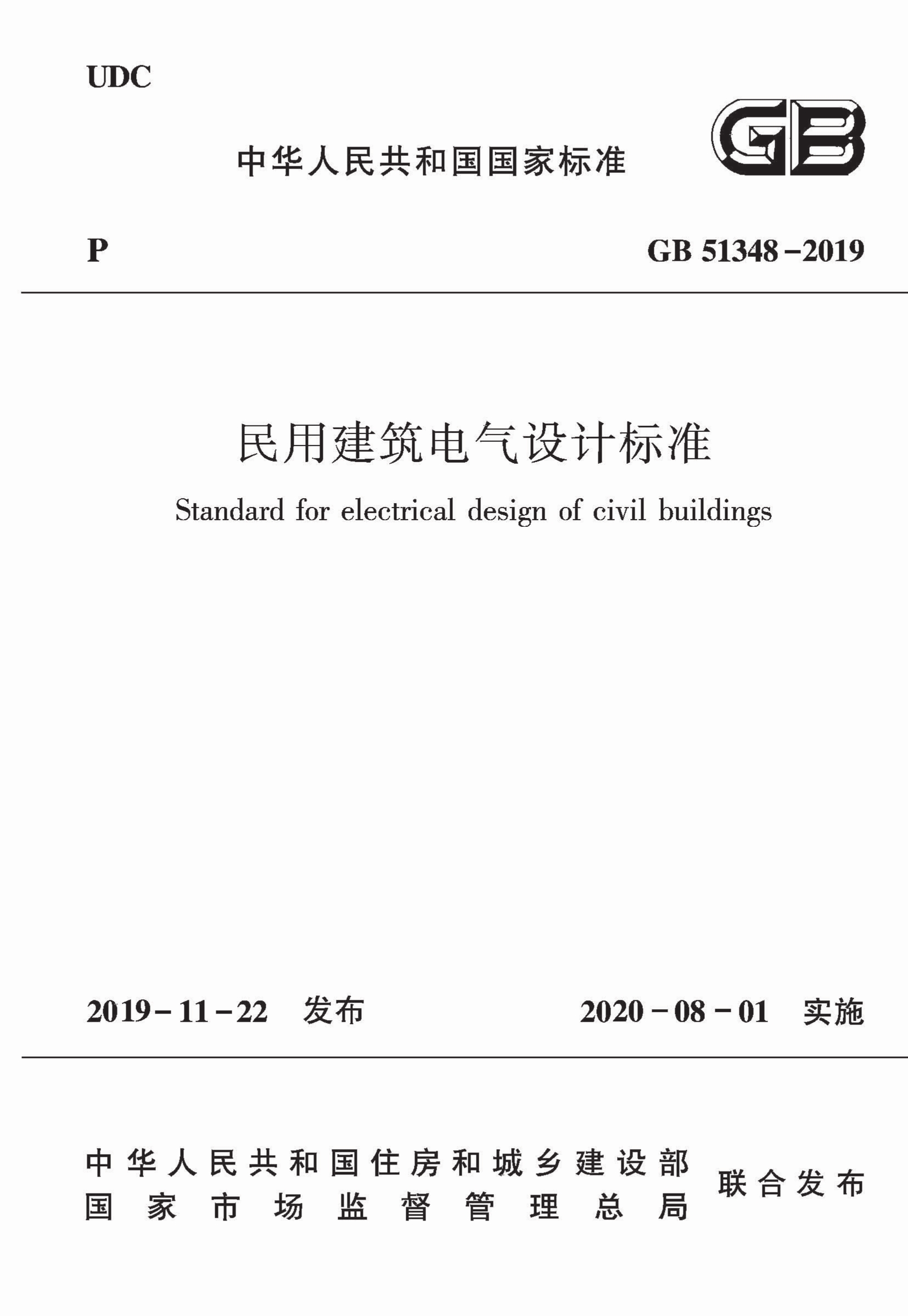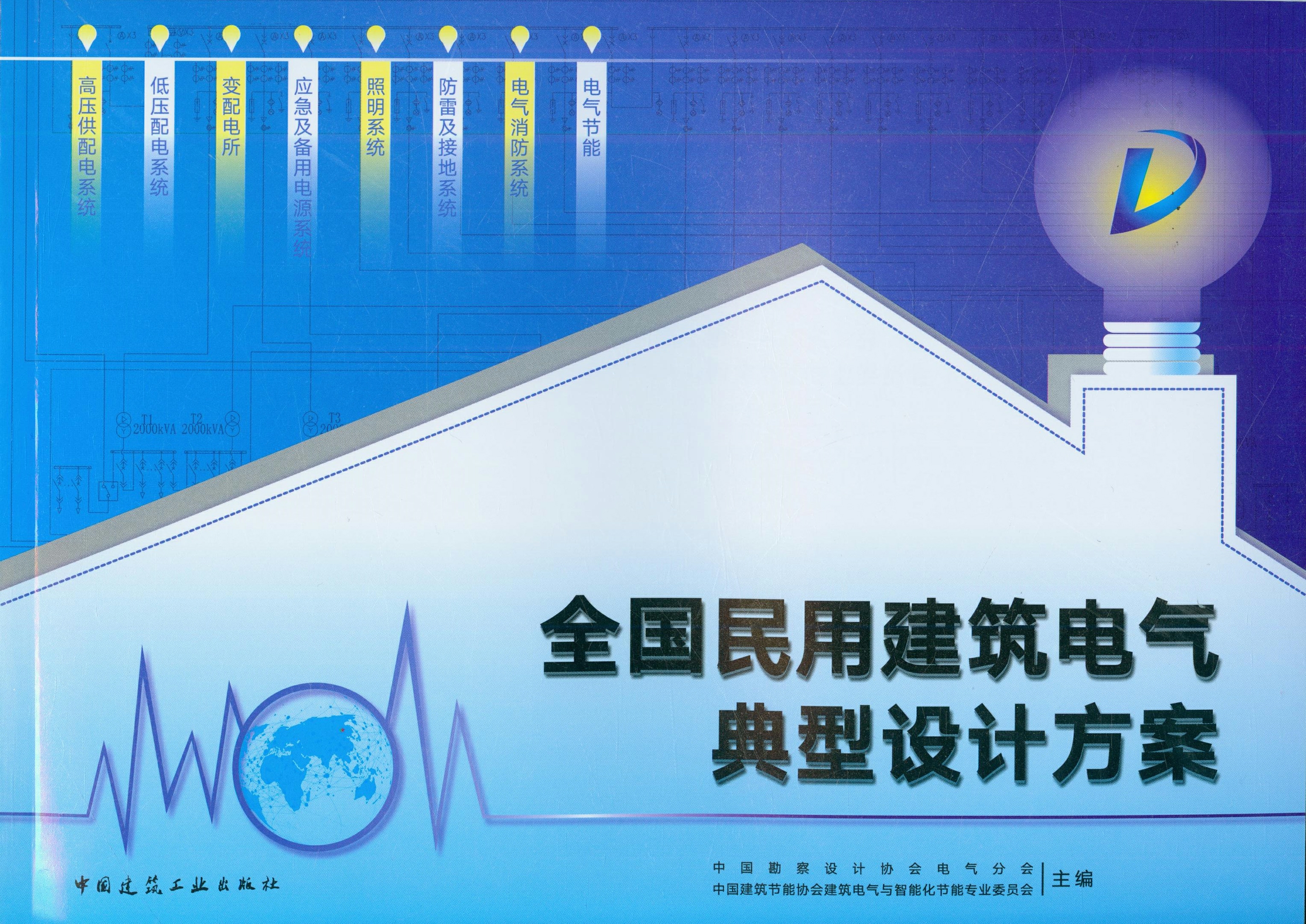发布日期:2019-11-22
实施日期:2020-08-01
主编部门:中华人民共和国住房和城乡建设部
主编单位:中国建筑东北设计研究院有限公司
主要起草人:王金元,孙兰,成彦,郭晓岩,李朝栋,于信涛,田英策,陈琪,孙成群,汪猛,邵民杰,陈众励,瞿二澜,杜毅威,杨德才,王东林,李炳华,熊江,陈汉民,陈建飚,曾敬梅,王可崇,王小安,张文才,李立晓,宋平健,黄晓红,曹玮,黄翔,叶本开,孙鲁雄,刘宏瑞,牟宏伟,朱爱荣,潘茂龙
出版社:中国建筑工业出版社
标准书号:15112·35495
出版时间:2020-07-01
本标准的主要技术内容是:1.总则;2.术语和缩略语;3.供配电系统;4.变电所;5.继电保护、自动装置及电气测量;6.自备电源;7.低压配电;8.配电线路布线系统;9.常用设备电气装置;10.电气照明;11.民用建筑物防雷;12.电气装置接地和特殊场所的电气安全防护;13.建筑电气防火;14.安全技术防范系统;15.有线电视和卫星电视接收系统;16.公共广播与厅堂扩声系统;17.呼叫信号和信息发布系统;18.建筑设备监控系统;19.信息网络系统;20.通信网络系统;21.综合布线系统;22.电磁兼容与电磁环境卫生;23.智能化系统机房;24.建筑电气节能;25.建筑电气绿色设计;26.弱电线路布线系统。
本标准适用于新建、改建和扩建的单体及群体民用建筑的电气设计,不适用于燃气加压站、汽车加油站的电气设计。
根据住房和城乡建设部 《关于印发 〈2013年工程建设标准规范制订、修订计划〉的通知》 (建标 〔2013〕6号)的要求,标准编制组经广泛调查研究,认真总结实践经验,参考有关国际标准和国外先进标准,并在广泛征求意见的基础上,对 《民用建筑电气设计规范》JGJ 16-2008进行了修订。
本标准的主要技术内容是:1.总则;2.术语和缩略语;3.供配电系统;4.变电所;5.继电保护、自动装置及电气测量;6.自备电源;7.低压配电;8.配电线路布线系统;9.常用设备电气装置;10.电气照明;11.民用建筑物防雷;12.电气装置接地和特殊场所的电气安全防护;13.建筑电气防火;14.安全技术防范系统;15.有线电视和卫星电视接收系统;16.公共广播与厅堂扩声系统;17.呼叫信号和信息发布系统;18.建筑设备监控系统;19.信息网络系统;20.通信网络系统;21.综合布线系统;22.电磁兼容与电磁环境卫生;23.智能化系统机房;24.建筑电气节能;25.建筑电气绿色设计;26.弱电线路布线系统。
本标准修订的主要内容是:
1.取消了锅炉房热工检测与控制一章;
2.增加了建筑电气节能、绿色建筑电气设计、弱电线路布线系统三章;
3.对保留的各章所涉及的主要技术内容进行了补充、完善和必要的修改。
本标准中以黑体字标志的条文为强制性条文,必须严格执行。
本标准由住房和城乡建设部负责管理和对强制性条文的解释,由中国建筑东北设计研究院有限公司负责具体技术内容的解释。执行过程中如有意见或建议,请寄送中国建筑东北设计研究院有限公司(地址:沈阳市和平区光荣街65号,邮编:110003)。
本标准主编单位:中国建筑东北设计研究院有限公司
本标准参编单位:中国建筑标准设计研究院有限公司 北京市建筑设计研究院有限公司 中国建筑设计研究院有限公司 华东建筑设计研究院有限公司 上海建筑设计研究院有限公司 天津市建筑设计院 中国建筑西南设计研究院有限公司 中国建筑西北设计研究院有限公司 中南建筑设计院股份有限公司 悉地(北京)国际建筑设计顾问有限公司 哈尔滨工业大学 广东省建筑设计研究院 福建省建筑设计研究院有限公司 中国核电工程有限公司 北京市避雷装置安全检测中心 上海市防雷中心 施耐德电气(中国)投资有限公司 ABB(中国)有限公司 上海高桥电缆集团有限公司 通用(天津)铝合金产品有限公司 沈阳斯沃电气有限公司 沈阳宏宇光电子科技有限公司 山东华凌电缆有限公司
本标准主要起草人员:王金元 孙兰 成彦 郭晓岩 李朝栋 于信涛 田英策 陈琪 孙成群 汪猛 邵民杰 陈众励 瞿二澜 杜毅威 杨德才 王东林 李炳华 熊江 陈汉民 陈建飚 曾敬梅 王可崇 王小安 张文才 李立晓 宋平健 黄晓红 曹玮 黄翔 叶本开 孙鲁雄 刘宏瑞 牟宏伟 朱爱荣 潘茂龙
本标准主要审查人员:丁杰 王勇 傅慈英 丁红军 李英武 沈育祥 周名嘉 海清 钟景华 张宜 施巨岭 朱立彤 焦建欣 李丹江 耿望阳 张钊
中华人民共和国住房和城乡建设部公告
2019年 第314号
住房和城乡建设部关于发布国家标准《民用建筑电气设计标准》的公告
现批准《民用建筑电气设计标准》为国家标准,编号为GB 51348-2019,自2020年8月1日起实施。其中,第3.2.1、3.2.8、3.3.4、4.3.5、4.7.3、4.10.1、7.2.4、7.4.6、7.5.2、7.6.3、8.1.6、9.4.5、11.2.3、11.2.4、11.8.8、12.4.10、12.4.14、12.5.8、13.4.6、13.7.6、14.4.3、14.9.4条为强制性条文,必须严格执行。原行业标准《民用建筑电气设计规范》JGJ 16-2008同时废止。
本标准在住房和城乡建设部门户网站(www.mohurd.gov.cn)公开,并由住房和城乡建设部标准定额研究所组织中国建筑出版传媒有限公司出版发行。
中华人民共和国住房和城乡建设部
2019年11月22日
目录
中华人民共和国住房和城乡建设部公告
前言
1 总则
2 术语和缩略语
2.1 术语
2.2 缩略语
3 供配电系统
3.1 一般规定
3.2 负荷分级及供电要求
3.3 电源及供配电系统
3.4 电压等级选择和电能质量
3.5 负荷计算
3.6 无功补偿
4 变电所
4.1 一般规定
4.2 所址选择
4.3 配电变压器选择
4.4 主接线及电器选择
4.5 变电所型式和布置
4.6 35kV、20kV、10kV配电装置
4.7 低压配电装置
4.8 并联电力电容器装置
4.9 所用电源及操作电源
4.10 对土建专业的要求
4.11 对暖通及给水排水专业的要求
5 继电保护、自动装置及电气测量
5.1 一般规定
5.2 继电保护的基本规定
5.3 配电变压器保护
5.4 20kV或10kV线路保护
5.5 35kV线路保护
5.6 35kV、20kV或10kV母线分段断路器保护
5.7 并联电容器保护
5.8 10kV异步电动机(电动机容量<2MW)保护
5.9 备用电源自动投入装置
5.10 应急柴油发电机组与正常电源的切换
5.11 数字式综合保护装置
5.12 变电站综合自动化系统
5.13 二次回路
5.14 中央信号装置
5.15 电气测量
5.16 电能计量
6 自备电源
6.1 自备柴油发电机组
6.2 应急电源
6.3 不间断电源
7 低压配电
7.1 一般规定
7.2 低压配电系统
7.3 特低电压配电
7.4 导体选择
7.5 低压电器的选择
7.6 低压配电线路的保护
7.7 低压配电系统的电击防护
8 配电线路布线系统
8.1 一般规定
8.2 直敷布线
8.3 刚性金属导管布线
8.4 可弯曲金属导管布线
8.5 电缆桥架布线
8.6 刚性塑料导管(槽)布线
8.7 电力电缆布线
8.8 预制分支电缆布线
8.9 耐火电缆和矿物绝缘电缆布线
8.10 母线槽布线
8.11 电气竖井内布线
8.12 铝合金电缆布线
8.13 照明母线槽布线
9 常用设备电气装置
9.1 一般规定
9.2 电动机
9.3 电梯、自动扶梯和自动人行道
9.4 自动旋转门、电动门、电动卷帘门和电动伸缩门窗
9.5 舞台用电及放映设备
9.6 医用设备
9.7 交流充电桩
9.8 其他用电设备
10 电气照明
10.1 一般规定
10.2 照明方式与种类
10.3 照度水平与照明质量
10.4 应急照明
10.5 照明光源与灯具
10.6 照明供电与控制
10.7 景观照明
11 民用建筑物防雷
11.1 一般规定
11.2 建筑物的防雷分类
11.3 第二类防雷建筑物的雷电防护措施
11.4 第三类防雷建筑物的雷电防护措施
11.5 其他防雷保护措施
11.6 接闪器
11.7 引下线
11.8 接地网
11.9 雷电电磁脉冲防护
11.10 防雷装置的材料要求
12 电气装置接地和特殊场所的电气安全防护
12.1 一般规定
12.2 交流电气装置接地的范围
12.3 交流电气装置的接地和接地电阻
12.4 低压配电系统的接地形式和基本要求
12.5 接地装置
12.6 通用用电设备接地
12.7 保护等电位联结
12.8 屏蔽接地及防静电接地
12.9 智能化系统接地
12.10 潮湿场所的安全防护
13 建筑电气防火
13.1 一般规定
13.2 系统设置
13.3 火灾自动报警系统设计
13.4 消防设施联动控制设计
13.5 电气火灾监控系统设计
13.6 消防应急照明系统设计
13.7 系统供电
13.8 线缆选择及敷设
13.9 非消防负荷线缆与通信电缆的选择
14 安全技术防范系统
14.1 一般规定
14.2 入侵报警系统
14.3 视频监控系统
14.4 出入口控制系统
14.5 电子巡查系统
14.6 停车库(场)管理系统
14.7 楼宇对讲系统
14.8 传输线路
14.9 安防监控中心
14.10 安防综合管理系统
14.11 应急响应系统
15 有线电视和卫星电视接收系统
15.1 一般规定
15.2 有线电视系统设计原则
15.3 有线电视系统接入
15.4 卫星电视接收系统
15.5 自设前端
15.6 HFC接入分配网
15.7 IP接入分配网
15.8 传输线路选择
16 公共广播与厅堂扩声系统
16.1 一般规定
16.2 公共广播系统
16.3 厅堂扩声系统
16.4 设备选择
16.5 设备布置
16.6 线路及敷设
16.7 控制室
16.8 供电电源、防雷与接地
17 呼叫信号和信息发布系统
17.1 一般规定
17.2 呼叫信号系统设计
17.3 信息引导及发布系统设计
17.4 时钟系统设计
17.5 设备选择及机房
17.6 供电电源、防雷与接地
18 建筑设备监控系统
18.1 一般规定
18.2 建筑设备监控系统网络结构
18.3 管理网络层
18.4 控制网络层
18.5 现场网络层
18.6 建筑设备监控系统的软件
18.7 现场仪表的选择
18.8 冷热源系统监控
18.9 空调及通风系统监控
18.10 给水与排水系统监控
18.11 供配电系统监测
18.12 照明系统监控
18.13 电梯和自动扶梯系统监控
18.14 建筑设备一体化监控系统
19 信息网络系统
19.1 一般规定
19.2 网络系统设计原则
19.3 网络系统逻辑设计
19.4 网络系统物理设计
19.5 网络管理与网络安全
19.6 网络服务器选择
19.7 网络互联设计
19.8 网络应用规划
19.9 无线局域网络
20 通信网络系统
20.1 一般规定
20.2 信息接入系统
20.3 用户电话交换系统
20.4 数字无线对讲系统
20.5 移动通信室内信号覆盖系统
20.6 甚小口径卫星通信系统
20.7 数字微波通信系统
20.8 会议系统
20.9 多媒体教学系统
21 综合布线系统
21.1 一般规定
21.2 系统设计
21.3 系统配置
21.4 系统指标
21.5 设备间及电信间
21.6 工作区设备
21.7 线缆选择和敷设
21.8 接地
22 电磁兼容与电磁环境卫生
22.1 一般规定
22.2 电磁环境卫生
22.3 供配电系统的谐波防治
22.4 电子信息系统的电磁兼容设计
22.5 接地与等电位联结
23 智能化系统机房
23.1 一般规定
23.2 机房设置
23.3 机房设计与布置
23.4 环境条件和对相关专业的要求
23.5 机房供电、接地及防静电
23.6 消防与安全
24 建筑电气节能
24.1 一般规定
24.2 供配电系统节能设计
24.3 电气照明的节能设计
24.4 动力装置的节能设计
24.5 建筑设备监控系统节能设计
24.6 其他
25 建筑电气绿色设计
25.1 一般规定
25.2 光伏发电系统
25.3 导光设备
25.4 能效监管系统
26 弱电线路布线系统
26.1 一般规定
26.2 园区综合管道
26.3 园区配线设施
26.4 建筑物引入管
26.5 建筑物内配线管网
26.6 建筑物内配线设施
附录A 民用建筑中各类建筑物的主要用电负荷分级
附录B 建筑物、入户设施年预计雷击次数及可接受的年平均雷击次数的计算
附录C 浴盆和淋浴盆(间)区域的划分
附录D 游泳池和戏水池区域的划分
附录E 喷水池区域的划分
附录F 声压级及扬声器所需功率计算
附录G 各类建筑物的混响时间推荐值及缆线规格计算与选择
本标准用词说明
引用标准名录
编制说明
Contents
1 General Provisions
2 Terms and Abbreviations
2.1 Terms
2.2 Abbreviations
3 Power Supply and Distribution System
3.1 General Requirements
3.2 Load Classification and Power Supply Requirements
3.3 Power Source and the Power Supply and Distribution System
3.4 Voltage Grade Selection and Power Quality
3.5 Load Calculation
3.6 Reactive Power Compensation
4 Substations
4.1 General Requirements
4.2 Station Site Selection
4.3 Distribution Transformer Selection
4.4 Main Connection and Electrical Apparatus Selection
4.5 Type and Arrangement of Distribution Substation
4.6 35kV,20kV or 10kV Distribution Equipment
4.7 Low Voltage Distribution Equipment
4.8 Shunt Power Capacitor Devices
4.9 Used Power Supply and Operational Power Supply
4.10 Requirements for Civil Engineering
4.11 Requirements for Heating,Ventilation and Water Supply and Drainage
5 Relay Protection,Automatic Equipment and Electrical Measurements
5.1 General Requirements
5.2 Basic Regulations of Relay Protection
5.3 Distribution Transformer Protection
5.4 20 kV or 10kV Line Protection
5.5 35kV Line Protection
5.6 35kV,20kV or 10kV Bus Section Breaker Protection
5.7 Shunt Capacitors Protection
5.8 10kV Asynchronous Motor (with Capacity <2MW)Protection
5.9 Regulations of Standby Power Automatic Input Device
5.10 Switch between Emergency Diesel Generator Set and Normal Power Source
5.11 Digital Integrated Protection Device
5.12 Substation Integrated Automation System
5.13 Secondary Circuit
5.14 Central Signal Device
5.15 Electrical Measurements
5.16 Electrical Energy Measurements
6 Self-contained Power Supply
6.1 Self-provided Diesel Generator Set
6.2 Emergency Power Supply
6.3 Uninterruptible Power Supply
7 Low Voltage Power Distributions
7.1 General Requirements
7.2 Low-voltage Distribution System
7.3 Extra-low Voltage Distribution
7.4 Selection of Conductor
7.5 Selection of Low-voltage Electrical Apparatus
7.6 Protection of Low-voltage Distribution Circuit
7.7 Protection against Electric Shock of Low-voltage Distribution System
8 Distribution Circuit Wiring System
8.1 General Requirements
8.2 Staple Wiring
8.3 Wiring with Rigid Metal Conduit
8.4 Wiring with Flexible Metal Conduit
8.5 Wiring with Cable Bridge
8.6 Wiring with Rigid Plastic Conduit (Groove)
8.7 Wiring of Power Cables
8.8 Wiring of Prefabricated Branching Cables
8.9 Wiring of Fire resistant Cables and Mineral Insulated Cables
8.10 Wiring of Busway
8.11 Wiring in Electrical Vertical Shaft
8.12 Wiring of Aluminum Alloy Cable
8.13 Wiring of Lighting Busway
9 Electrical Installation of Common Equipment
9.1 General Requirements
9.2 Motor
9.3 Elevator,Escalator and Moving Sidewalk
9.4 Automatic Revolving Door and Electrically Operated Gate and Electrically Operated Roller Shutters,Electrically Operated Retractable Door and Window
9.5 Electricity of Stage and Projection Equipment
9.6 Medical Equipment
9.7 AC Charging Spots
9.8 Other Electrical Equipment
10 Electric Lighting
10.1 General Requirements
10.2 Lighting Style and Type
10.3 Luminance Level and Lighting Quality
10.4 Emergency Lighting
10.5 The Lighting Source and Light Fittings
10.6 Lighting Power Supply and Lighting Control
10.7 Landscape Lighting
11 Lightning Protection of Civil Buildings
11.1 General Requirements
11.2 The Lightning Protection Classification of Buildings
11.3 Lightning Protection Measures of Class Ⅱ Lightning Protection Buildings
11.4 Lightning Protection Measures of Class Ⅲ Lightning Protection Buildings
11.5 Other Lightning Protection Measures
11.6 Arrester
11.7 Down-lead
11.8 Earthing Grid
11.9 Lightning Electromagnetic Impulse Protection
11.10 Material Requirements of Lightning Protection Device
12 Electrical Installation Grounding and Electrical Safety Protections for Special Locations
12.1 General Requirements
12.2 Grounding Scope of the AC Electrical Installations
12.3 Grounding and Grounding Resistance of the AC Electrical Installations
12.4 Grounding Forms and Basic Requirements for Low-voltage Distribution System
12.5 Grounding Device
12.6 Grounding of the General Electrical Equipment
12.7 Protective Equipotential Bonding
12.8 Shielding Grounding and Anti-static Grounding
12.9 Grounding of Intelligent System
12.10 Safety Protections at All Moist Places
13 Electrical Fire Prevention of Buildings
13.1 General Requirements
13.2 System Setting
13.3 Automatic Fire Alarm System Design
13.4 Integrated Fire Protection Control Design
13.5 Electrical Fire Monitoring System Design
13.6 Fire Emergency Lighting System Design
13.7 Mains Power Supply
13.8 Selection and Laying of the Wires&Cables
13.9 Selection of the Non-fire Load Cables and Communication Cables
14 Security Technology Protection Systems
14.1 General Requirements
14.2 Intrusion Alarm System
14.3 Video Security Monitoring System
14.4 Access Control System
14.5 Electronic Patrol System
14.6 Parking Garage (Lot) Management System
14.7 Building Intercom System
14.8 Transmission Line
14.9 Security Monitoring Center
14.10 Security Integrated Management System
14.11 Emergency Response System
15 CATV and Satellite TV Receiving System
15.1 General Requirements
15.2 CATV System Design Principle
15.3 CATV System Access
15.4 Satellite Television Receiving System
15.5 Self-setting Head-end
15.6 HFC Access&Distribution Network
15.7 IP Access&Distribution Network
15.8 Selection of the Transmission Lines
16 Public Broadcasting and Auditorium Sound Reinforcement System
16.1 General Requirements
16.2 Public Broadcasting System
16.3 Auditorium Sound Reinforcement System
16.4 Equipment Selection
16.5 Equipment Arrangement
16.6 Lines and Line Laying
16.7 Control Room
16.8 Power Supply,Lightning Protection and Grounding
17 Calling Signals and Information Release System
17.1 General Requirements
17.2 Design of Calling Signals System
17.3 Design of Information Guidance and Release System
17.4 Design of Clock System
17.5 Equipment Selection and Information Rooms
17.6 Power Supply,Lighting Protection and Grounding
18 Building Automation System
18.1 General Requirements
18.2 Network Structure of the Building Automation System
18.3 Management Network Layer
18.4 Control Network Layer
18.5 Field Network Layer
18.6 Software of the Building Automation System
18.7 Selection of Field Instruments
18.8 Monitoring of Heating and Cooling System
18.9 Monitoring of Air Conditioning and Ventilation System
18.10 Monitoring of Water Supply and Drainage System
18.11 Monitoring of Power Supply and Distribution System
18.12 Monitoring of Lighting System
18.13 Monitoring of Elevator and Escalator System
18.14 Integrated Building Equipment Monitoring System
19 Information Network System
19.1 General Requirements
19.2 Network System Design Principle
19.3 Network System Logic Design
19.4 Network System Physical Design
19.5 Network Management and Network Security
19.6 Network Server Selection
19.7 Network Interconnection Design
19.8 Network Application Programming
19.9 Wireless Local Area Network
20 Communication Network System
20.1 General Requirements
20.2 Information Access System
20.3 Telephone Switching System
20.4 Digital Wireless Intercom System
20.5 Indoor Signal Coverage of Mobile Communication System
20.6 Very Small Aperture Satellite Communication System
20.7 Digital Microwave Communication System
20.8 Conference System
20.9 Multimedia Teaching System
21 Generic Cabling System
21.1 General Requirements
21.2 System Design
21.3 System Configuration
21.4 System Index
21.5 Equipment Room and Telecommunication Room
21.6 Equipment of Work Area
21.7 Selection and Laying of Cable
21.8 Grounding
22 Electromagnetic Compatibility and Electromagnetic Environmental Health
22.1 General Requirements
22.2 Electromagnetic Environmental Health
22.3 Harmonic Prevention of Power Supply and Distribution System
22.4 The Electromagnetic Compatibility Design of Electronic Information System
22.5 Grounding and Equipotential Bonding
23 Intelligent System Equipment Rooms
23.1 General Requirements
23.2 Information Room Settings
23.3 Design and Layout of the Information Rooms
23.4 Environmental Conditions and Work Requirements for the Relevant Specialties
23.5 Power Supply,Grounding and Anti-static of Information Rooms
23.6 Firefighting and Security
24 Electrical Energy Saving for Buildings
24.1 General Requirements
24.2 Energy Saving Design for Power Supply and Distribution System
24.3 Energy Saving Design for Electric Lighting
24.4 Energy Saving Design for Power Plant
24.5 Energy Saving Design for Building Automation System
24.6 Others
25 Building Electrical Green Design
25.1 General Requirements
25.2 Photovoltaic System
25.3 Optic Guiding Equipment
25.4 Energy Efficiency Supervision System
26 Weak Current Circuit Wiring System
26.1 General Requirements
26.2 Park Comprehensive Pipeline
26.3 Park Wiring Facilities
26.4 Inlet Pipes of Buildings
26.5 Distribution Pipe Network in Buildings
26.6 Wiring Facilities in Buildings
Appendix A Major Electrical Load Classification of Civil Buildings
Appendix B Calculation of Estimated Frequency and Receivable Average Annual Frequency of Lighting Stroke for the Buildings and Indoor Facilities
Appendix C Partition of Bathtub and Shower Tray(Cubicle)
Appendix D Division of Swimming Pools and Wading Pools
Appendix E Division of the Fountain
Appendix F Calculation of Sound Pressure Level and Required Power for Loudspeaker
Appendix G Recommended Values of Reverberation Time for All Kinds of Buildings,Calculations and Selections of Cable Specification
Explanation of Wording in This Standard
List of Quoted Standards
3.2.1 用电负荷应根据对供电可靠性的要求及中断供电所造成的损失或影响程度确定,并符合下列要求。
1 符合下列情况之一时,应定为一级负荷:
1)中断供电将造成人身伤害;
2)中断供电将造成重大损失或重大影响;
3)中断供电将影响重要用电单位的正常工作,或造成人员密集的公共场所秩序严重混乱。
特别重要场所不允许中断供电的负荷应定为一级负荷中的特别重要负荷。
2 符合下列情况之一时,应定为二级负荷:
1)中断供电将造成较大损失或较大影响;
2)中断供电将影响较重要用电单位的正常工作或造成人员密集的公共场所秩序混乱。
3 不属于一级和二级的用电负荷应定为三级负荷。
3.2.8 一级负荷应由双重电源供电,当一个电源发生故障时,另一个电源不应同时受到损坏。
3.3.4 应急电源与正常电源之间,应采取防止并列运行的措施。
4.3.5 设置在民用建筑内的变压器,应选择干式变压器、气体绝缘变压器或非可燃性液体绝缘变压器。
4.7.3 当成排布置的配电柜长度大于6m时,柜后面的通道应设置两个出口。当两个出口之间的距离大于15m时,尚应增加出口。
4.10.1 可燃油油浸变压器室以及电压为35kV、20kV或10kV的配电装置室和电容器室的耐火等级不得低于二级。
7.2.4 供避难场所使用的用电设备,应从变电所采用放射式专用线路配电。
7.4.6 电气装置外可导电部分,严禁用作保护接地导体(PEN)。
7.5.2 在TN-C系统中,严禁断开保护接地中性(PEN)导体,且不得装设断开保护接地中性导体的任何电器。
7.6.3 对于突然断电比过负荷造成损失更大的线路,不应设置过负荷保护。
8.1.6 在有可燃物的闷顶和封闭吊顶内明敷的配电线路,应采用金属导管或金属槽盒布线。
9.4.5 室外带金属构件的电动伸缩门的配电线路,应设置过负荷保护、短路保护及剩余电流动作保护电器,并应做等电位联结。
11.2.3 符合下列情况之一的建筑物,应划为第二类防雷建筑物:
1 高度超过100m的建筑物;
2 国家级重点文物保护建筑物;
3 国家级会堂、办公建筑物、档案馆、大型博展建筑物;特大型、大型铁路旅客站;国际性的航空港、通信枢纽;国宾馆、大型旅游建筑物;国际港口客运站;
4 国家级计算中心、国家级通信枢纽等对国民经济有重要意义且装有大量电子设备的建筑物;
5 特级和甲级体育建筑;
6 年预计雷击次数大于0.05的部、省级办公建筑物及其他重要或人员密集的公共建筑物;
7 年预计雷击次数大于0.25的住宅、办公楼等一般民用建筑物。
11.2.4 符合下列情况之一的建筑物,应划为第三类防雷建筑物:
1 省级重点文物保护建筑物及省级档案馆;
2 省级大型计算中心和装有重要电子设备的建筑物;
3 100m以下,高度超过54m的住宅建筑和高度超过50m的公共建筑物;
4 年预计雷击次数大于或等于0.01且小于或等于0.05的部、省级办公建筑物及其他重要或人员密集的公共建筑物;
5 年预计雷击次数大于或等于0.05且小于或等于0.25的住宅、办公楼等一般民用建筑物;
6 建筑群中最高的建筑物或位于建筑群边缘高度超过20m的建筑物;
7 通过调查确认当地遭受过雷击灾害的类似建筑物;历史上雷害事故严重地区或雷害事故较多地区的较重要建筑物;
8 在平均雷暴日大于15d/a的地区,高度大于或等于15m的烟囱、水塔等孤立的高耸构筑物;在平均雷暴日小于或等于15d/a的地区,高度大于或等于20m的烟囱、水塔等孤立的高耸构筑物。
11.8.8 当采用敷设在钢筋混凝土中的单根钢筋作为防雷装置时,钢筋的直径不应小于10mm。
12.4.10 采用TN-C-S系统时,当PEN导体从某点分开后不应再合并或相互接触,且中性导体不应再接地。
12.4.14 下列部分严禁接地:
1 采用设置非导电场所保护方式的电气设备外露可导电部分;
2 采用不接地的等电位联结保护方式的电气设备外露可导电部分;
3 采用电气分隔保护方式的单台电气设备外露可导电部分;
4 在采用双重绝缘及加强绝缘保护方式中的绝缘外护物里面的外露可导电部分。
12.5.8 铝导体不应作为埋设于土壤中的接地极和接地连接导体(线)。
13.4.6 疏散照明应在消防控制室集中手动、自动控制。不得利用切断消防电源的方式直接强启疏散照明灯。
13.7.6 消防水泵、防烟风机和排烟风机不得采用变频调速器控制。
14.4.3 疏散通道上设置的出入口控制装置必须与火灾自动报警系统联动,在火灾或紧急疏散状态下,出入口控制装置应处于开启状态。
14.9.4 安防监控中心应设置为禁区,应有保证自身安全的防护措施和进行内外联结的通信装置,并应设置紧急报警装置和留有向上一级接处警中心报警的通信接口。









